Partner publications
Category:

Uganda Launches the FP2030 commitments
On the 3rd November, Uganda launched the FP2030 commitments. The objective of the launch was to create awareness, understanding and momentum leading to the global launch that is due November 18th 2021. Uganda has made several commitments towards the FP 2030 to address the gaps in ensuring access to family planning commodities.
Reproductive health Uganda alongside other civil society organizations will partner with the Ministry of Health to see the commitments to fruition.
Speaking at the launch, the minister of Health Dr. Jane Ruth Aceng underlined that Government is keen on implementing its commitments on family planning. She said the focus should now change to the boy child.
Speaking at the launch of the Uganda Family Planning 2030 Commitments in Kampala on Wednesday, Aceng said boys ‘need to know the dangers of making a teenage girl pregnant’. ‘The focus has been on the recipient of the pregnancy and not the giver.’

Over the past nine years, governments, civil society, multilateral organizations, donors, the private sector and the research community, have come together around an ambitious goal: to enable 120 million additional women and girls to use modern contraception by 2020. Working together in partnership, much has been achieved, but more remains to be done.
The global family planning community agreed that the gains of the last nine years should be sustained by extending this pivotal partnership. Through a global consultation, stakeholders from around the world provided their input on the future of family planning. Together, the community created a shared vision for 2030 that builds on progress achieved to date, adapts the partnership in response to the lessons of the first nine years and positions us to achieve the future women and girls around the world are asking for.
The collective feedback has formed the basis of a vision, guiding principles, and focus areas. With this foundation, and informed by the family planning community consultation, the new partnership will be built over the course of 2021.
The Uganda Family Planning 2030 Commitments include the following:
– to increase equitable access and voluntary use of modern contraceptive methods for all women and couples
– to increase funding for adolescent sexual and reproductive health programmes
– to ensure contraceptive commodity security
– to strengthen the policy and enabling environment for family planning
– to strengthen the policy and enabling environment for family planning
– to strengthen family planning data use at all levels
– to address family planning myths and misconceptions through evidence-based sexual and behavioral change communication and advocacy
Guiding Principles of the commitments
- Voluntary, person-centered, rights-based approaches, with equity at the core: This guiding principle reflects the fundamental belief that individuals should be able to freely make choices that reflect their desires and needs. Every decision, action, and investment made by the partnership will reflect this belief – that each person has the same right to quality family planning, regardless of their geography, socioeconomic status, gender, or culture.
- Empowering women and girls and engaging men, boys, and communities: Positive male inclusion is needed to truly transform normalization of family planning and at the same time share the burden of the decisions and implications of family planning. This must happen in tandem with empowerment of women and girls to create true equity.
- Building intentional and equitable partnerships with adolescents, youth, and marginalized populations to meet their needs, including for accurate and disaggregated data collection and use: These populations have been consistently underserved, so the partnership commits to prioritizing them in all future work.
- Country-led global partnerships, with shared learning and mutual accountability for commitments and results: Country commitments drive progress with support from regional and global stakeholders for implementation, coordination, and accountability.

Getting Cultural leaders on Board
At Reproductive Health Uganda, we strongly believe that especially local leaders are pivotal and key in promoting family planning in their communities. We have been engaging the different leaders in the communities around Uganda, see article from one of the major ones from Lango culture.
See attached excerpt from the biggest news paper in Uganda
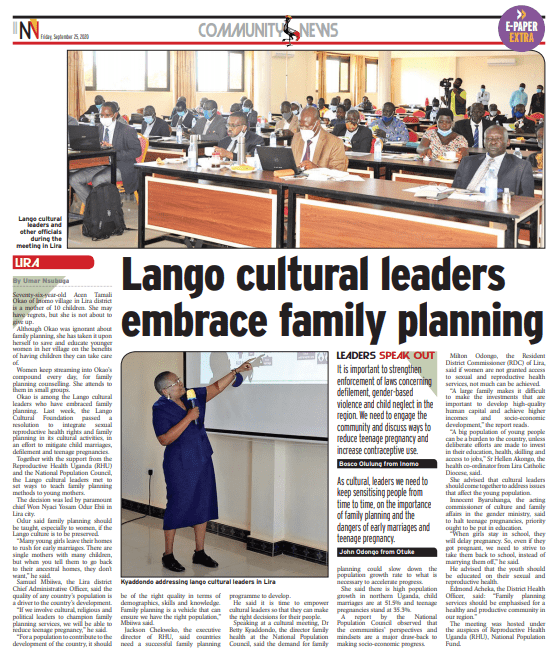
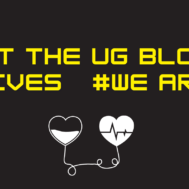
#SupportTheUGBloodBank #SaveLives
Saving lives through greater investment in safe blood transfusion services
#SupportTheUGBloodBank #SaveLives #WeAreRHU
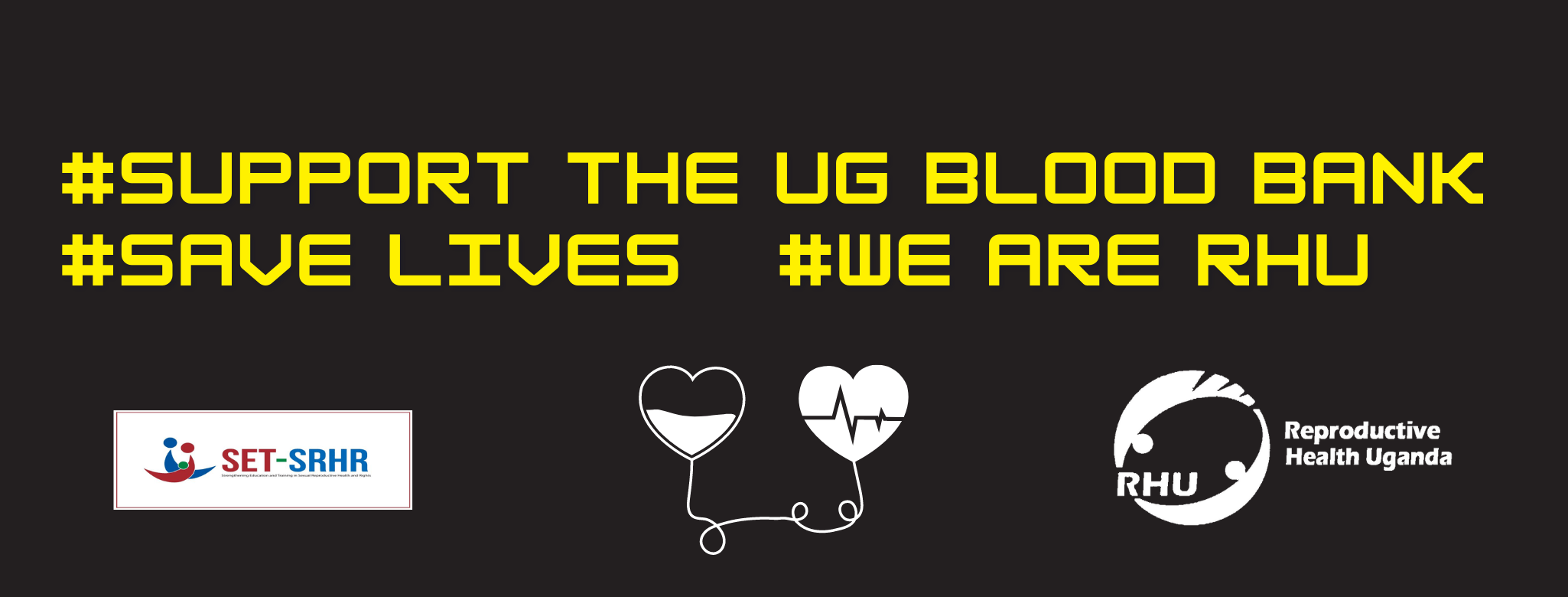
Join the conversation on social media,using #SupportTheUGBloodBank #SaveLives #WeAreRHU
Did you know: It is not enough to just donate blood? See why it is important to donate and get on board. Change starts with you, you never know when you will need the blood.
Background and context
The Government of Uganda has made significant strides in providing access to safe and sufficient blood to Ugandans who need it. Data from Uganda Blood Transfusion Services (UBTS) shows that the total units of blood collected annually has increased from 131,226 in 2007/2008 to 274,308 in 2018/19 Financial Year. Regional blood banks have been established in 7 locations; blood collection centres have also been set up in 9 other locations and the national blood bank at Nakasero has been revamped to provide better services. Government has gradually increased funding for blood, especially following the exit of PEPFAR in 2017 e.g. from Uganda Shillings 23.815 billion in FY 2016/17 to 46.94 billion in FY 2019/2020. The Ministry of Health Annual Report of 2017/2018 shows that 87 (48%) of the country’s 187 HCIVs were offering Comprehensive Emergency Obstetric Care (CEmOC) in 2018, having increased from 44.6% in 2016/17 FY and blood transfusion is a key requirement in the provision of CEmOC. Increased access to blood has contributed to a reduction in maternal mortality from 418 per 100,000 live births in 2006 to 368 in 2016; and a reduction in child mortality rates between 1995 and 2016 from 156 to 64 per 1,000 live births among others.
Cause for concern?
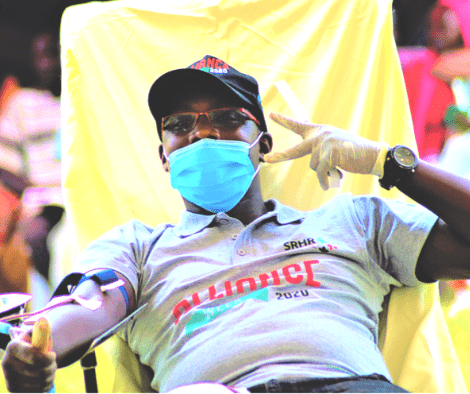 Despite the aforementioned progress, significant challenges persist. Recent engagement between UBTS and selected Civil society organisations highlighted a number of teething challenges: such as inadequate funding i.e. if UBTS is to collect 495,030 Units of blood (as per WHO requirement of 1% of the Uganda population) at 80.8[1] USD a unit, it will need Uganda Shillings 156 billion in 2021[2]. This is 3 times more than the current funding of Uganda Shillings 46.94 billion (Exchange rate of MoF-3900 Ugx/1USD)[3]. There is inadequate infrastructure- e.g. inadequate storage facilities for blood and medical supplies in many of the Regional Blood Banks; inadequate transport and staffing to meet the desired collection and supply target among others;
Despite the aforementioned progress, significant challenges persist. Recent engagement between UBTS and selected Civil society organisations highlighted a number of teething challenges: such as inadequate funding i.e. if UBTS is to collect 495,030 Units of blood (as per WHO requirement of 1% of the Uganda population) at 80.8[1] USD a unit, it will need Uganda Shillings 156 billion in 2021[2]. This is 3 times more than the current funding of Uganda Shillings 46.94 billion (Exchange rate of MoF-3900 Ugx/1USD)[3]. There is inadequate infrastructure- e.g. inadequate storage facilities for blood and medical supplies in many of the Regional Blood Banks; inadequate transport and staffing to meet the desired collection and supply target among others;
The catch?
Indeed, Uganda will not attain the goal of universal health coverage without addressing the myriad of challenges associated with supply and distribution of blood at all levels of the health system. Data from UBTS shows that a total of 274,308 Units of blood was collected in 2018/19 representing approximately 60% of the country’s total blood requirement during the year. UBTS estimates that Uganda will require 495,030 Units of blood in 2021 and 510,030 in 2022 based on current population growth projection. Currently, 29% of the total blood collected is used for treating people with severe malaria; 17% is for treating pregnant women with anaemia and complications of child birth; 17% for treating people with sickle cell anaemia, 15% for treating cancer cases, 6% for accident cases and 16% for treating other cases (burns, surgical operations) (UBTS).
Ensuring affordable, accessible, acceptable and good quality health care for all Uganda’s will reduce the inequality gap but also ensure that key programmes like UBTS are efficient in tackling the persistent service delivery challenges in the health sector.
Our plan!
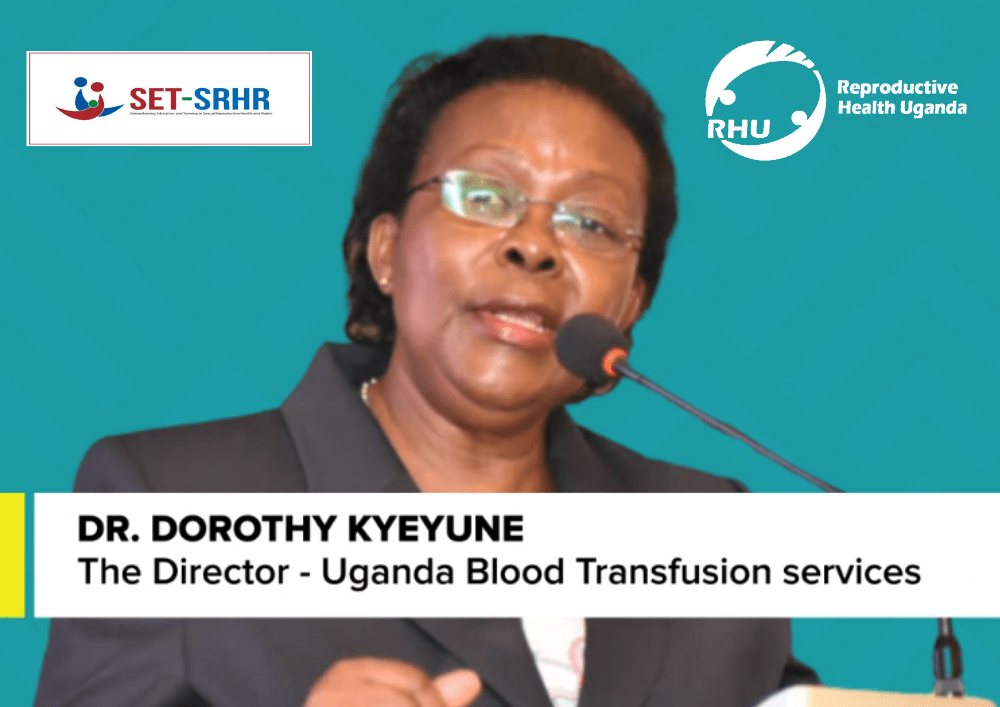
The national policy dialogue on availability and accessibility to safe blood for improved maternal health outcomes in Uganda is being organised against the backdrop of persistent media reports of blood shortage in some public health facilities which has led to avoidable maternal deaths at such facilities. This situation has been exacerbated by the COVID 19 pandemic which has brought severe restrictions on gatherings like schools and other community mobilisations which were the major platforms for blood donation drives. In the recent past, MoH has sought additional 20.5 billion shillings in supplementary budget allocation to fund blood collection during the COVID-19 lock down. While this is a welcome relief especially if it’s approved and the funds made available to the Ministry, it does not address the recurring problem of under funding of blood collection and maternal health services generally. There is need for significant and sustainable financing for UBTS and blood transfusion services beyond the firefighting approach through the supplementary allocations.
This dialogue will build on and reinforce the ongoing civil society campaigns led by CEHURD which calls for increased government funding for blood and blood transfusion services, especially following the exit of PEPFAR in 2017. The dialogue which will be held on mass media (TV, Print/online, and social media) is being organised by Reproductive Health Uganda (RHU) and Makerere University School of Public Health (MakSPH) under the SETSRHR project in collaboration with Centre for Human Rights and Development (CEHURD).
Objectives of the dialogue
Organized under the theme: Saving Lives through greater investment in safe blood transfusion services, the national policy dialogue seeks to mobilize support for and increase commitment towards the achievement of universal access to safe blood transfusion services and improve health outcomes in the country. To that end, the policy dialogue aims to achieve the following specific objectives:
- To highlight the persistent challenge of blood shortage and access to blood in our health system and how these are undermining national efforts to address maternal morbidity and mortality.
- To provide opportunity for policy makers, practitioners and beneficiaries to examine the underlying issues underpinning blood shortage and blood access in our health system and how these can be addressed in a sustainable manner;
- Advocate for adequate and sustainable financing for blood transfusion services and maternal health services generally;
- Strengthen partnerships between relevant government agencies (at national and sub-national levels), civil society organisations and private sector for effective and efficient delivery of blood transfusion services in the country.
The road map
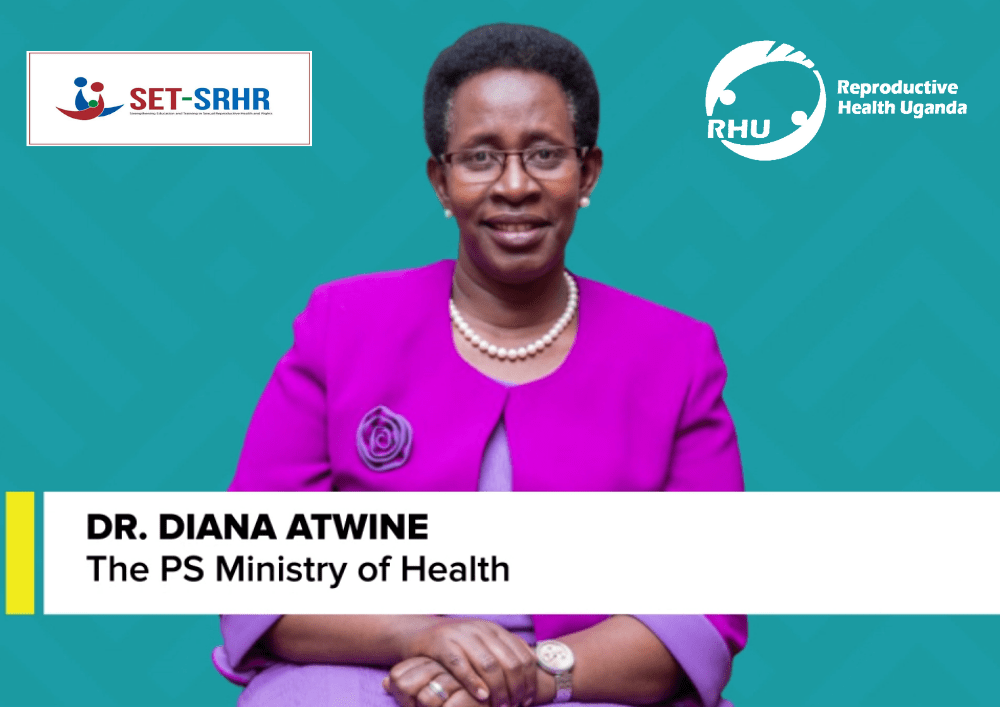
-
- Special report: under the headline “no woman should die giving life”, the special report will be based on observations at selected health facilities and experiences of/interviews with health policy makers, service providers, opinion leaders and end users. It will highlight the issues related to availability and access to safe blood from the perspective of policy makers, service providers, blood donors and end users. The report will be aired on NBS Television and preceding the talkshows.
- Television talk Shows: a total of 3 talk shows will be conducted on NBSTV. It will build on the investigative stories. Each talk show will examine the issue of availability and access to safe blood from different perspectives.
- The first talk show will focus at the macro-level looking at the national requirements, current provisions, enabling policies, gaps and challenges in human resources, financing, partnerships, technical support and opportunities for improvements
- The second talk show will delve into the technical and operational challenges faced by frontline service providers in ensuring adequate, timely and quality blood transfusion services and the opportunities for addressing identified gaps
- The third and last talk show will look at the demand side constraints focusing on the experiences of end users and how these can be addressed. The talk shows will be simultaneously relayed on selected radio stations.
- Newspaper publications: newspaper articles will be based on data and information from field interviews (policy and decision makers, service providers and end users) and review of secondary data from published sources. The articles will be published in the 2 leading dailies-New vision and Daily Monitor. The newspaper articles will be published during the same week as the TV talk shows and will mirror the themes addressed by the TV talk shows. The newspaper articles will be written by leading journalists from New vision and Monitor publications.
- Promotional adverts: the adverts will run on NBS for a period of 1 month and will aim at promoting blood donation in the country and mobilising communities for this.
- Social media engagements: The 3 TV talk shows discussions and corresponding donation drive adverts will be highlighted on different social media platforms; Twitter: @nbstv; @SolomonSerwanjj; @RHUganda; @cehurduganda; @SETSRHRUg. Facebook: @rhuganda; @CehurdUG. This will give the public an opportunity to contribute to the discussions at hand and also be involved in the donation drives.
- Participants for the Talk Shows
- Talk show moderator: The talk shows will be moderated by Solomon Serwanja, a seasoned investigative journalist and news anchor with NBSTV. In 2019 Serwanjja was awarded the Komla Dumor Award, an annual award given by the BBC to celebrate African journalists. He is also very passionate and vocal about the issue of access to blood and issues around maternal and reproductive health. Solomon will also lead the TV investigative story coverage.
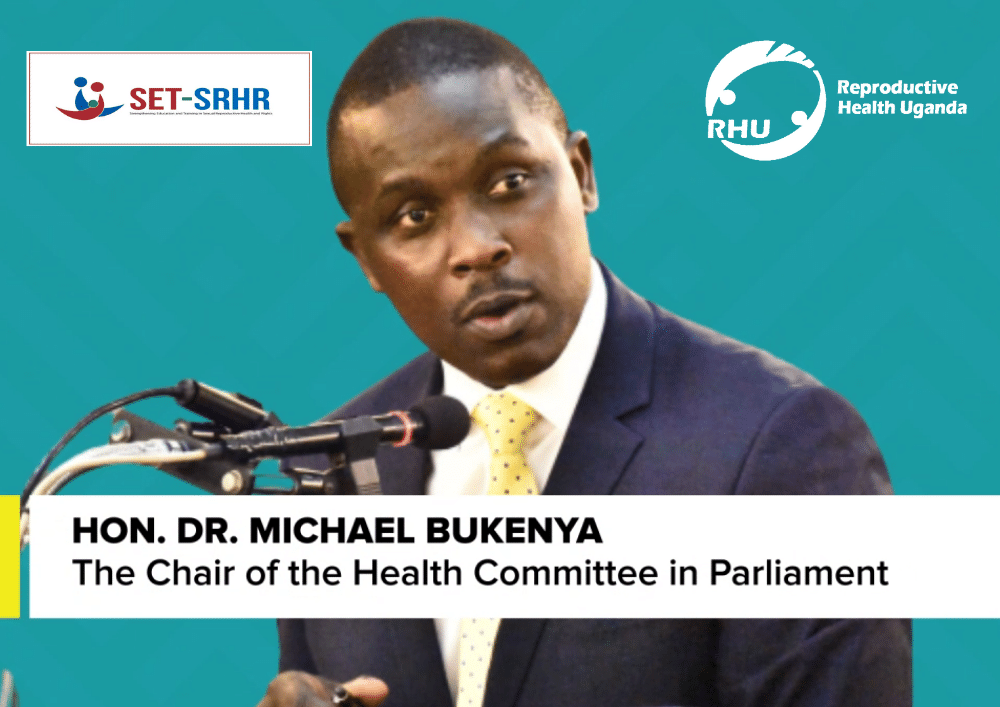
5.2 First Talk Show Panellists
- In the Studio: The Chair of the Parliamentary Committee on Health – Michael Bukenya, Permanent secretary MoH – Dr. Diana Atwine, and Executive Director, UBTS, Dr. Dorothy Kyeyune.
- Via Zoom: Executive Director RHU, Mr. Jackson Chekweko, and Executive Director CSBAG.
5.3 Second Talk show Panellists
- In the studio: Director Health Services, Ministry of Health, Charles Olaro, Relevant Technical Officer from UBTS – TBC, Director Arua regional Referral Hospital –Dr. Philbert Nyeko
- Via zoom: Executive Director CEHURD – Moses Mulumba, and Representative from Uganda Red Cross Society and Rep. from Mengo Hospital.
5.3 Third Talk Show Panellists;
- In the Studio: Director Obstetrics and Gynaecology Mulago Hospital – Professor Annet Nakimuli, representative of health Consumers, Representative of UBTS
- Via Zoom: someone with extensive relevant research, President of the Uganda Obstetrics and Gynaecology Association -TBC, Private sector
On social media, the conversation will use #SupportTheUGBloodBank #SaveLives #WeAreRHU
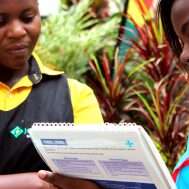
Not ready to get pregnant yet? Here are a few things you could do
These are very unprecedented times. We are no longer dealing with the same challenges as we were before. Times where we knew how not to spread HIV/AIDS or at least contain it. We could easily treat or prevent Sexually Transmitted Infections and disease (STDs/STIs). And now? Chlamydia, Gonorrhoea, Syphilis and even THE HIV/AIDs itself are no match for the Novel Corona virus.
These are indeed very uncertain times, with governments all over the world taking drastic measures to lock down, restrict movements and yet with diminutive hope or certainty that things will go back to normal soon.
Take caution :
With most people working from home or on forced leave and movement restrictions, loneliness, boredom with the so much time is paramount. For those staying with their partners the idea of sex must be flaunting. I mean ‘things’ are freely available on full time basis right?
Please note: Even if you are under self or institutional quarantine, having unprotected sex will still expose you to STIs and STDs and unplanned pregnancies.
But since abstinence is a complicated subject even without the CORONA virus, how can one enjoy their things without fear of getting pregnant or contracting STDS or STIs?
How do i not get pregnant?
Using contraceptives allows people to attain their desired number of children and determine the spacing of pregnancies. They are also very helpful in times such as these where one wouldn’t want to get pregnant.
There are however two methods one can use to delay pregnancy; Traditional and modern methods these are broken down below;
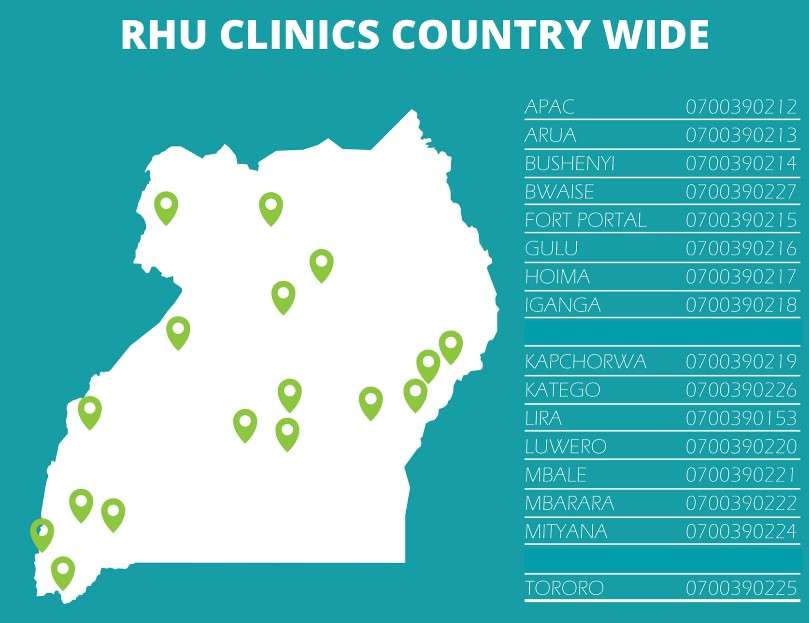
Reproductive Health Uganda clinics remain open across the country You can call any of the clinics in charges for appointments and or questions
What are the Modern methods?
PS: We recommend using modern methods because of their accuracy. They can easily be relied on without fear. These methods are available at any of the Reproductive Health Clinics countrywide. Give us a call to make an appointment
| Method | Description | How it works | Effectiveness to prevent pregnancy | Comments | |
| Combined oral contraceptives (COCs) or “the pill” | Contains two hormones (estrogen and progestogen) | Prevents the release of eggs from the ovaries (ovulation) | >99% with correct and consistent use | Reduces risk of endometrial and ovarian cancer | |
| 92% as commonly used | |||||
| Progestogen-only pills (POPs) or “the minipill” | Contains only progestogen hormone, not estrogen | Thickens cervical mucous to block sperm and egg from meeting and prevents ovulation | 99% with correct and consistent use | Can be used while breastfeeding; must be taken at the same time each day | |
| 90–97% as commonly used | |||||
| Implants | Small, flexible rods or capsules placed under the skin of the upper arm; contains progestogen hormone only | Thickens cervical mucous to block sperm and egg from meeting and prevents ovulation | >99% | Health-care provider must insert and remove; can be used for 3–5 years depending on implant; irregular vaginal bleeding common but not harmful | |
| Progestogen only injectables | Injected into the muscle or under the skin every 2 or 3 months, depending on product | Thickens cervical mucous to block sperm and egg from meeting and prevents ovulation | >99% with correct and consistent use | Delayed return to fertility (about 1–4 months on the average) after use; irregular vaginal bleeding common, but not harmful | |
| 97% as commonly used | |||||
| Monthly injectables or combined injectable contraceptives (CIC) | Injected monthly into the muscle, contains estrogen and progestogen | Prevents the release of eggs from the ovaries (ovulation) | >99% with correct and consistent use | Irregular vaginal bleeding common, but not harmful | |
| 97% as commonly used | |||||
| Combined contraceptive patch and combined contraceptive vaginal ring (CVR) | Continuously releases 2 hormones – a progestin and an estrogen- directly through the skin (patch) or from the ring. | Prevents the release of eggs from the ovaries (ovulation) | The patch and the CVR are new and research on effectiveness is limited. Effectiveness studies report that it may be more effective than the COCs, both as commonly and consistent or correct use. | The Patch and the CVR provide a comparable safety and pharmacokinetic profile to COCs with similar hormone formulations. | |
| Intrauterine device (IUD): copper containing | Small flexible plastic device containing copper sleeves or wire that is inserted into the uterus | Copper component damages sperm and prevents it from meeting the egg | >99% | Longer and heavier periods during first months of use are common but not harmful; can also be used as emergency contraception | |
| Intrauterine device (IUD) levonorgestrel | A T-shaped plastic device inserted into the uterus that steadily releases small amounts of levonorgestrel each day | Thickens cervical mucous to block sperm and egg from meeting | >99% | Decreases amount of blood lost with menstruation over time; Reduces menstrual cramps and symptoms of endometriosis; amenorrhea (no menstrual bleeding) in a group of users | |
| Male condoms | Sheaths or coverings that fit over a man’s erect penis | Forms a barrier to prevent sperm and egg from meeting | 98% with correct and consistent use | Also protects against sexually transmitted infections, including HIV | |
| 85% as commonly used | |||||
| Female condoms | Sheaths, or linings, that fit loosely inside a woman’s vagina, made of thin, transparent, soft plastic film | Forms a barrier to prevent sperm and egg from meeting | 90% with correct and consistent use | Also protects against sexually transmitted infections, including HIV | |
| 79% as commonly used | |||||
| Male sterilization (vasectomy) | Permanent contraception to block or cut the vas deferens tubes that carry sperm from the testicles | Keeps sperm out of ejaculated semen | >99% after 3 months semen evaluation | 3 months delay in taking effect while stored sperm is still present; does not affect male sexual performance; voluntary and informed choice is essential | |
| 97–98% with no semen evaluation | |||||
| Female sterilization (tubal ligation) | Permanent contraception to block or cut the fallopian tubes | Eggs are blocked from meeting sperm | >99% | Voluntary and informed choice is essential | |
| Lactational amenorrhea method (LAM) | Temporary contraception for new mothers whose monthly bleeding has not returned; requires exclusive or full breastfeeding day and night of an infant less than 6 months old | Prevents the release of eggs from the ovaries (ovulation) | 99% with correct and consistent use | A temporary family planning method based on the natural effect of breastfeeding on fertility | |
| 98% as commonly used | |||||
| Emergency contraception pills (ulipristal acetate 30 mg or levonorgestrel 1.5 mg) | Pills taken to prevent pregnancy up to 5 days after unprotected sex | Delays ovulation | If all 100 women used progestin-only emergency contraception, one would likely become pregnant. | Does not disrupt an already existing pregnancy | |
| Standard Days Method or SDM | Women track their fertile periods (usually days 8 to 19 of each 26 to 32 day cycle) using cycle beads or other aids | Prevents pregnancy by avoiding unprotected vaginal sex during most fertile days. | 95% with consistent and correct use. | Can be used to identify fertile days by both women who want to become pregnant and women who want to avoid pregnancy. Correct, consistent use requires partner cooperation. | |
| 88% with common use (Arevalo et al 2002) | |||||
| Basal Body Temperature (BBT) Method | Woman takes her body temperature at the same time each morning before getting out of bed observing for an increase of 0.2 to 0.5 degrees C. | Prevents pregnancy by avoiding unprotected vaginal sex during fertile days | 99% effective with correct and consistent use. | If the BBT has risen and has stayed higher for 3 full days, ovulation has occurred and the fertile period has passed. Sex can resume on the 4th day until her next monthly bleeding. | |
| 75% with typical use of FABM (Trussell, 2009) | |||||
| Two Day Method | Women track their fertile periods by observing presence of cervical mucus (if any type color or consistency) | Prevents pregnancy by avoiding unprotected vaginal sex during most fertile days, | 96% with correct and consistent use. | Difficult to use if a woman has a vaginal infection or another condition that changes cervical mucus. Unprotected coitus may be resumed after 2 consecutive dry days (or without secretions) | |
| 86% with typical or common use. (Arevalo, 2004) | |||||
| Sympto-thermal Method | Women track their fertile periods by observing changes in the cervical mucus (clear texture) , body temperature (slight increase) and consistency of the cervix (softening). | Prevents pregnancy by avoiding unprotected vaginal sex during most fertile | 98% with correct and consistent use. | May have to be used with caution after an abortion, around menarche or menopause, and in conditions which may increase body temperature. | |
| Reported 98% with typical use (Manhart et al, 2013) | |||||
Traditional methods
| Traditional Method | Description | How it works | Effectiveness to prevent pregnancy | Comments | |
| Calendar method or rhythm method | Women monitor their pattern of menstrual cycle over 6 months, subtracts 18 from shortest cycle length (estimated 1st fertile day) and subtracts 11 from longest cycle length (estimated last fertile day) | The couple prevents pregnancy by avoiding unprotected vaginal sex during the 1st and last estimated fertile days, by abstaining or using a condom. | 91% with correct and consistent use. | May need to delay or use with caution when using drugs (such as anxiolytics, antidepressants, NSAIDS, or certain antibiotics) which may affect timing of ovulation. | |
| 75% with common use | |||||
| Withdrawal (coitus interruptus) | Man withdraws his penis from his partner’s vagina, and ejaculates outside the vagina, keeping semen away from her external genitalia | Tries to keep sperm out of the woman’s body, preventing fertilization | 96% with correct and consistent use | One of the least effective methods, because proper timing of withdrawal is often difficult to determine, leading to the risk of ejaculating while inside the vagina. | |
| 73% as commonly used (Trussell, 2009) | |||||
What if I am already pregnant?
Well no need to panic at all, Babies indeed are a blessing. Make sure to take good care of yourself and avoid stress. Reproductive Health Uganda clinics are open and you can visit at any working time, Monday- Saturday or better still, call ahead and set yourself an appointment with our well trained doctors.
Our prices are subsidised and are affordable. RHU boosts of over 60 years experience in providing quality and exceptional reproductive health services.

‘We’re not baby factories’: the refugees trying injectable contraceptives
‘We’re not baby factories’: the refugees trying injectable contraceptives- Article from the Guardian.com
Women who’ve fled South Sudan to Uganda are overcoming social stigma to explore new family planning options.
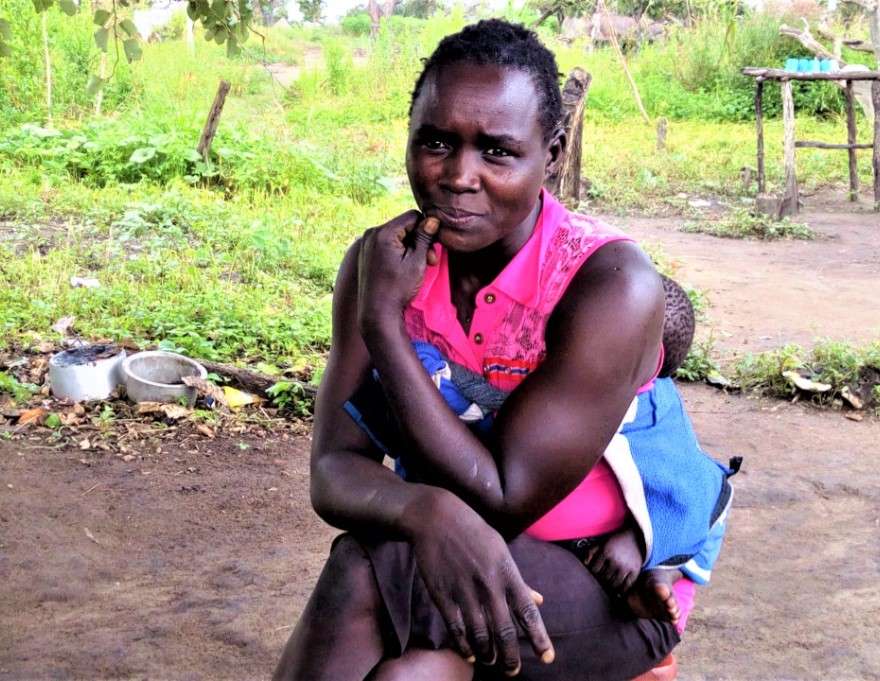
Christine Lamwaka fled South Sudan and now lives in the Palabek refugee settlement in Uganda. Photograph: Samuel Okiror
Christine Lamwaka and her husband gathered their six children and fled. It was April 2017 and their town in South Sudan had just been attacked. They walked for two days from Eastern Equatoria before crossing the border into Uganda.
“It was hard to flee with the young children. We struggled to run. I thought we couldn’t make it alive,” says Lamwaka, who was 22 at the time of the attack.
“We suffered a lot. I had given birth just a few months before and was breastfeeding. The children were crying. We are lucky to be alive.”
As well as ensuring her children were safe and the family had food and shelter, Lamwaka wanted to make sure she didn’t have any more children. But she was unable to access family planning services.
many children is very hard. We don’t have money for treating them, feeding and providing basic necessities,” says Lamwaka, from the safety of Palabek refugee settlement in Lamwo, northern Uganda. “We couldn’t afford to add more children.”
Research conducted by the Liverpool School of Tropical Medicine last year found that more than 40% of women in refugee settlements in northern Uganda who wanted to use contraceptives were unable to obtain them.
“Many health facilities in refugee camps are out or under-stocked,” said Simon Richard Mugenyi, advocacy and communications manager at Reproductive Health Uganda (RHU). Those seeking services often have to wait for organisations such as RHU to provide them.
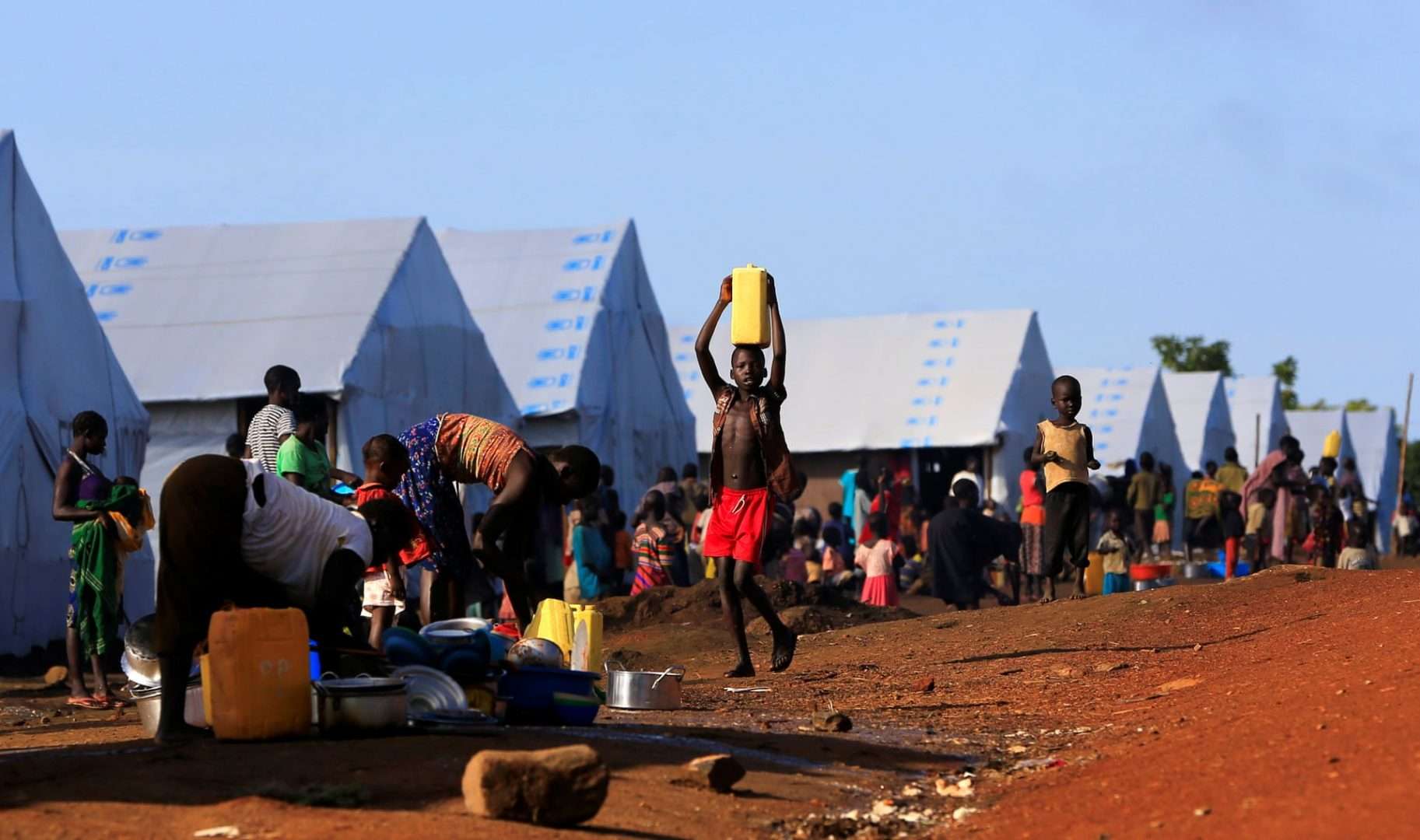
South Sudanese refugees in the Palabek camp in Lamwo, northern Uganda. Photograph: James Akena/Reuters
Last year, however, Lamwaka enrolled in a pilot programme for a single-use, self-injectable contraceptive, Sayana Press. The contraceptive is being rolled out by the NGO Path Uganda, with support from the UN population fund (UNFPA), to promote increased uptake of family planning among refugees.”
In South Sudan, deep-rooted socio-cultural factors discourage family planning. The inevitable upshot is larger families. On average, women in South Sudan have 4.6 children. Among women aged 15 to 49 who are married or in a relationship, only 10% use any form of contraception. According to the UNFPA, this is the lowest rate in east and southern Africa, and many women have their first child while in their teens.
“I started giving birth while still a teenager. I was giving birth almost every year. There was no time to rest or for child spacing,” says Lamwaka.
“They need you to produce more children. Women are looked at as factories for babies. Men expect women to be producing a child every year.
“Women are not allowed to decide the number, timing and spacing of children.”
Uganda now hosts more than 1.3 million refugees, more than 850,000 of whom are from South Sudan.
About 75% of the more than 50,000 South Sudanese refugees at Palabek are women and children.
Lamwaka was pleased when she found out about the self-injectable contraception, which is taken every three months. It means she won’t have to seek out a health worker when she needs it, which is not always straightforward in a refugee camp.
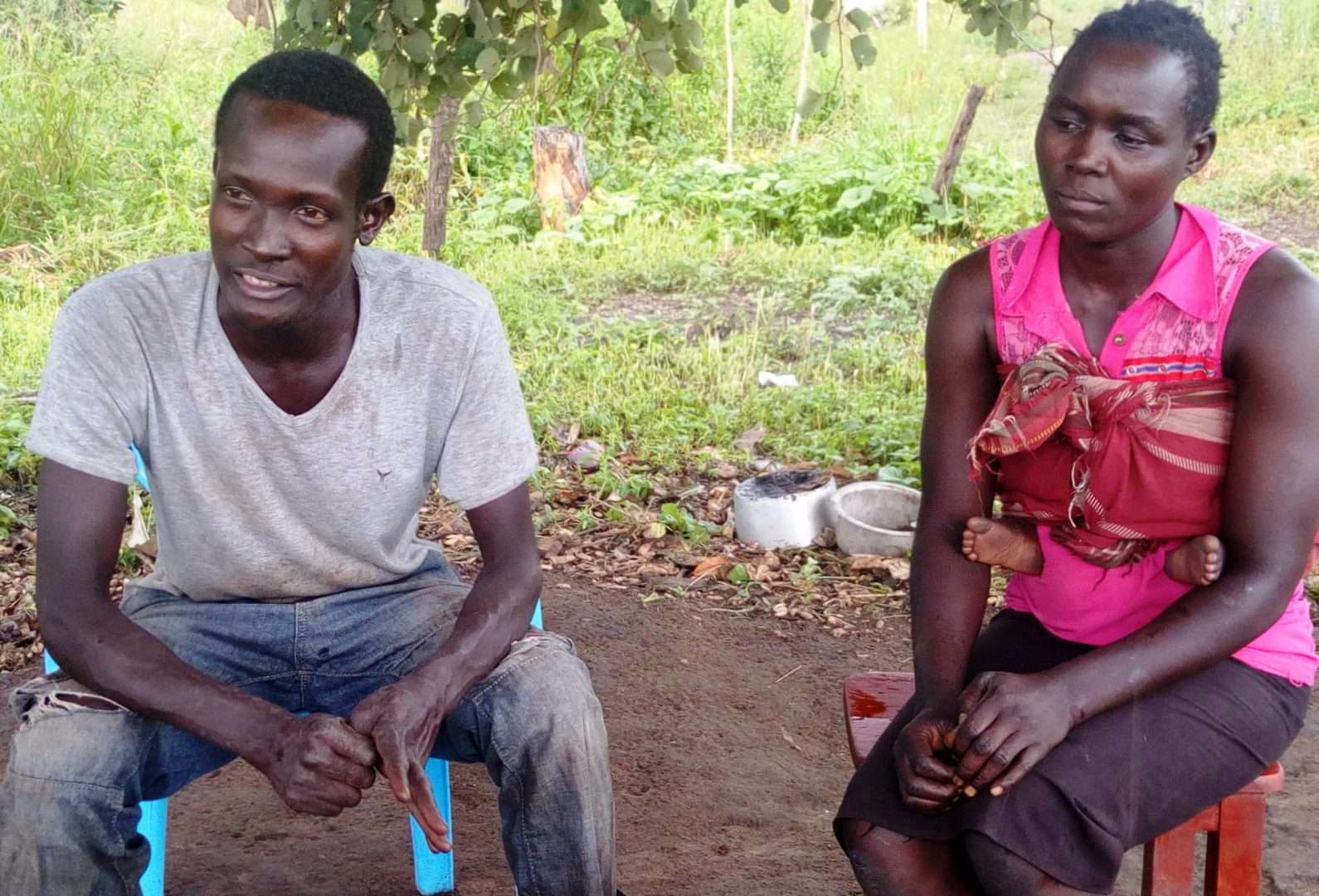
Christine Lamwaka and her husband Solomon Olum decided that Christine should enrol in the Sayana Press programme. Photograph: Samuel Okiror
She and her husband, Solomon Olum, decided she should enrol in the programme. “We are struggling to raise these children. I don’t have a job. I am a farmer. But I don’t have enough land to farm here. I have to burn charcoal and do hard labour to get money to support the family,” says Olum.
More than 9,000 women began taking Sayana Press, a variation on the established contraceptive Depo-Provera, between April and November last year.
Edson Twesigye, a programme officer for Sayana Press, says the pilot scheme resulted in 43% more women accessing contraceptive services.
“This is a big achievement,” he says. “These are refugee women who had never used any family planning method in their lives because of cultural beliefs, lack of access, or other reasons. Reaching 43% is a great milestone.”
Julitta Onabanjo, the UNFPA regional director for east and southern Africa, says: “This is something we can take as a lesson learned as we look at how to introduce it into [our] programmes in other countries.”
Millions of women still don’t have access to contraceptives – report
There were social stigmas to overcome before the rollout of the new contraceptive, says Twesigye. His team had conversations with community and religious leaders, to position family planning “not as a way of stopping having children, as they thought, but as a way of planning how many children you want, when to have them and when to stop,” he explains.
He adds that men in village health teams in the area were also talking to other men to help them better understand family planning.
“Many women in these settings have a desire to plan their families and don’t have any method that suits them. Therefore being able to give them any option of [family planning] method is very important,” says Onabanjo.
Mugenyi says the Ugandan government must spend more on contraceptives, starting with the allocation of the $5m (£3.8m) it committed to provide each year at the family planning summit held in 2017.
“If the government honored this commitment, this would help to stock family planning commodities in public facilities, including those in refugee camps,” he says
